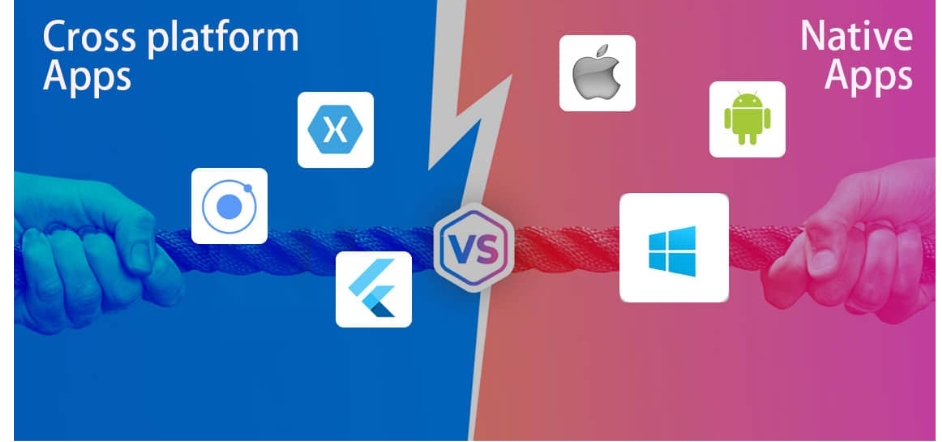Are you thinking about launching a new mobile app for your business? One of the most important decisions is developing the app natively or cross-platformly. Your choice can significantly impact cost, time, and functionality.
This article will explore native vs. cross-platform mobile app development and their pros and cons.
Native App Development
Native applications are specifically for a single platform. For example, you could develop a native Android app using Java; for iOS apps, you must choose Swift. Native apps can deliver a great user experience. However, mobile app development companies must consider the high cost of native app development, as parallel development is required for both platforms.
Here are some Native app development attributes.
Pros
Better User Experience
iOS and Android apps have significantly different user interfaces. Customers who prefer a specific platform are used to a particular screen design and find native mobile app examples more convenient.
Full Access to Device Features
Native applications can utilize all the features and functionality of the device to provide an integrated user experience. With full access to the device’s features, especially platform-specific built-in security features, native applications are more secure.
Easy Implementation and Release
The final process of publishing applications in Play Stores is as simple as possible because the features offered by native apps perfectly meet all their requirements.
Cons
Lack of Code Reusability
Native apps are built using specific code. To make a native app for Android and iOS users, you must develop two native apps. Therefore, the code for native mobile apps cannot be reused for multiple platforms.
Higher Cost
Native apps are platform-based, and you must build two separate applications for iOS and Android users. Their costs are higher. Even if you create a single native app, the price would be higher due to the specialty required to build it.
Increased Time of Development
Native app development takes longer than creating a single cross-platform app because two apps with separate codebases will require longer to build. Moreover, just like cost, building a single native mobile app might take longer than building a cross-platform app due to the unique skills required.
Cross-Platform App Development
Cross-platform development involves creating an app that works on several platforms. It saves time and cost, but it might mean sacrificing some quality.
Here are some pros and cons of cross-platform mobile app development.
Pros
Code Reusability
Cross-platform mobile app development utilizes a single codebase across different platforms, simplifying the development process through code reusability.
Less Costly
Developing a cross-platform mobile app is cheaper than creating native mobile apps. Instead of two native app development teams, you need only a single development team can perform all the duties in your chosen cross-platform framework. Creating a single application that can work on multiple platforms can also reduce costs and optimize time and team effort.
Faster Development
A single development cycle to create an app that runs on multiple platforms reduces the dimension of the mobile app development team you hire for your project. Instead of having two teams of developers, you will need a single team for a complete project in the cross-platform app development process.
Launch on Both iOS and Android
Since the cross-platform app focuses on several platforms, it’ll enter those markets simultaneously. This will increase the number of potential users and the chances of getting them to download your program.
Cons
Low-Level of Performance
Cross-platform apps must utilize a runtime environment to communicate with the underlying platform. Since another layer of computation is required, performance may be less smooth for specific applications, mainly if they rely heavily on data.
Fewer Integrations
Cross-platform frameworks can not integrate all platform-specific features and functions. Since there are fewer integrations, the user experience seems less natural. The cross-platform application only naturally has access to some of the platform’s features. However, the need for full integration sometimes arises depending on what you need from the app tasks.
Late Access to Platform Features
Cross-platform frameworks typically wait to access the latest updates when new platform SDK releases are rolled out. As a result, cross-platform apps can not perform parallel to native apps, making them feel less attractive to users.
Conclusion
Choosing native or cross-platform mobile app development has different pros and cons. However, the decision depends on the project requirements and the developers’ skills. Native mobile apps are the best choice for an enhanced user experience and top-notch performance. Ignoring the fact that native mobile apps cost more, you can have lower defect rates and enjoy better visuals. Cross-platform mobile apps are easy and quick to build, but delivering an equivalent user experience on the platform will require more effort.
Sign up for our Daily newsletter
We'll be in your inbox every morning Monday-Saturday with all the day’s top business news, inspiring stories, best advice and reporting from Entrepreneur,


